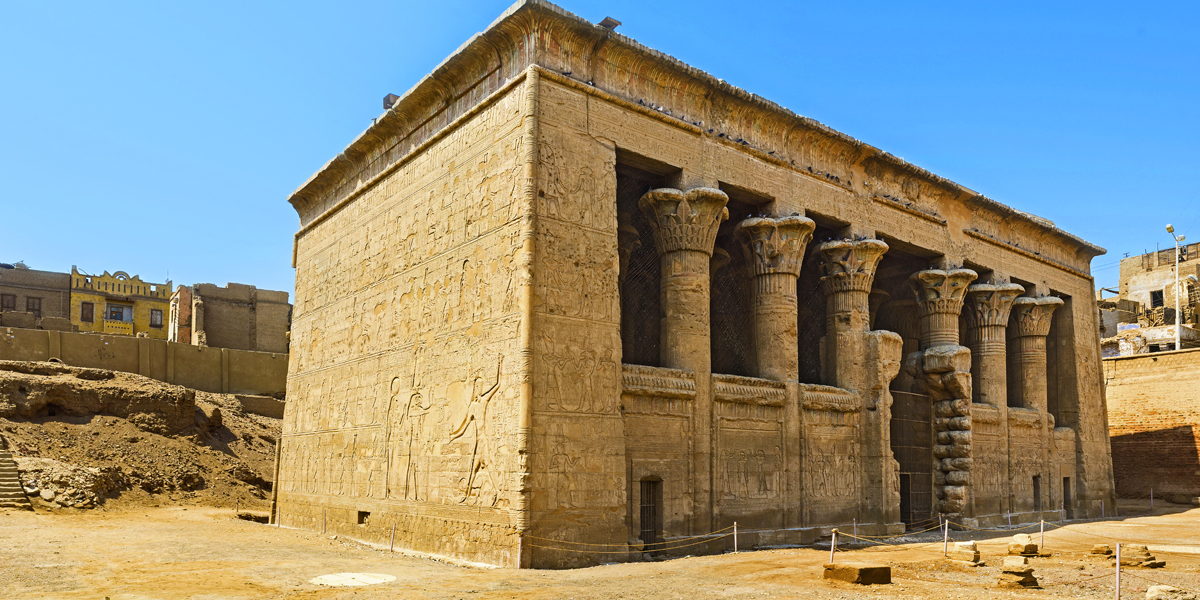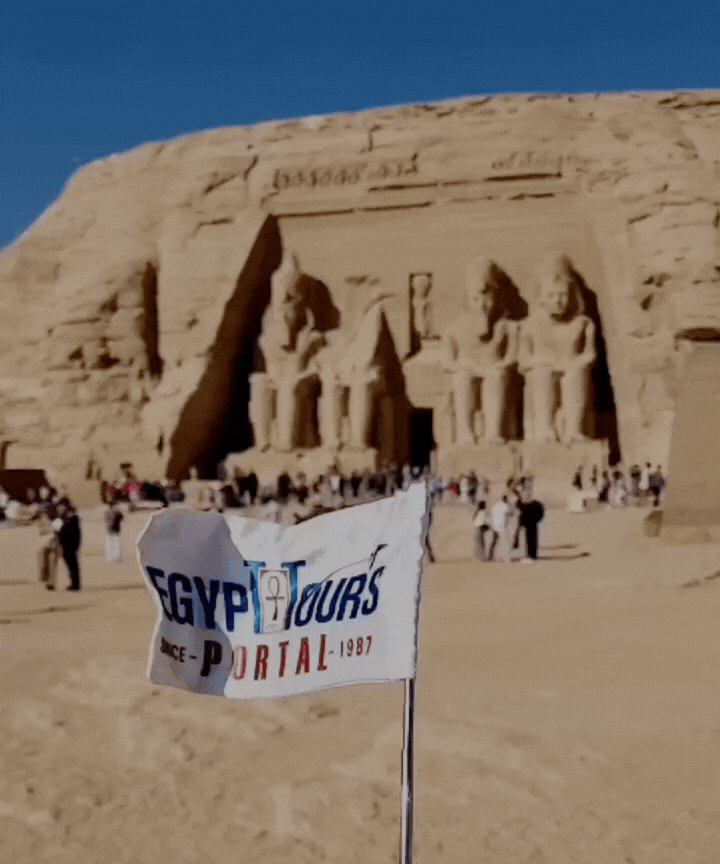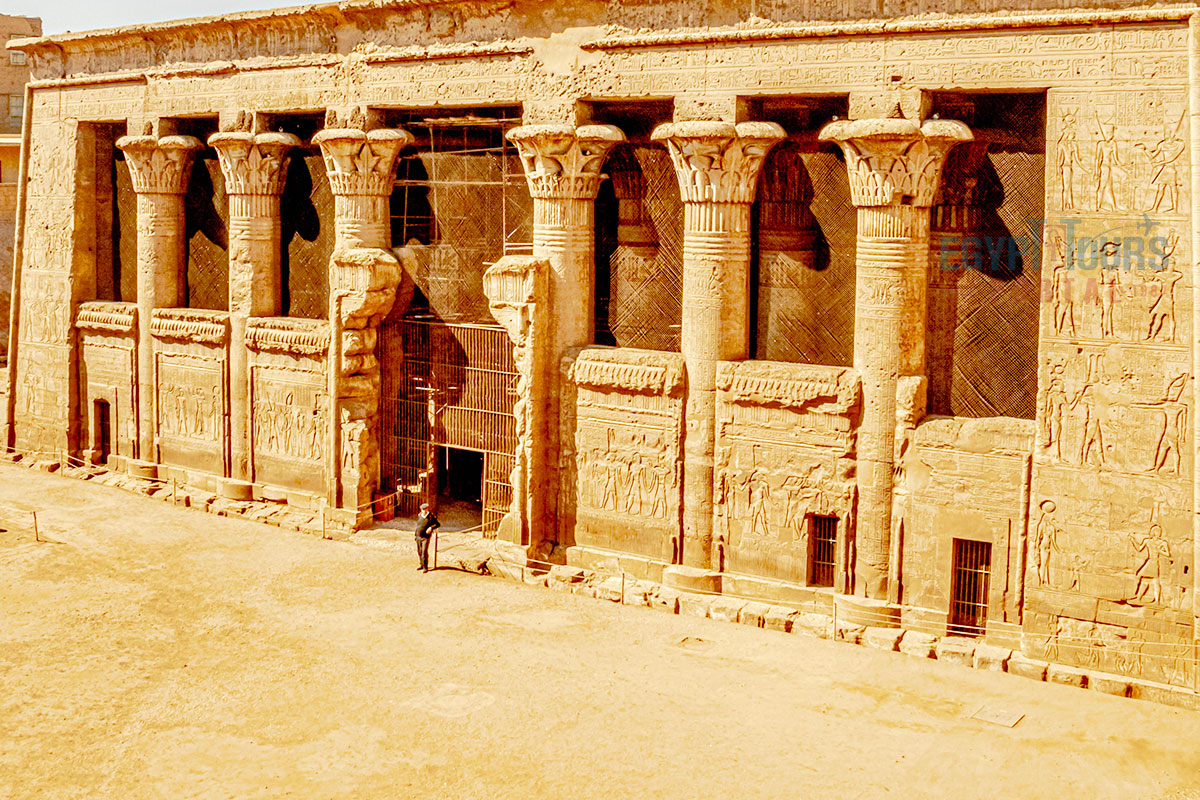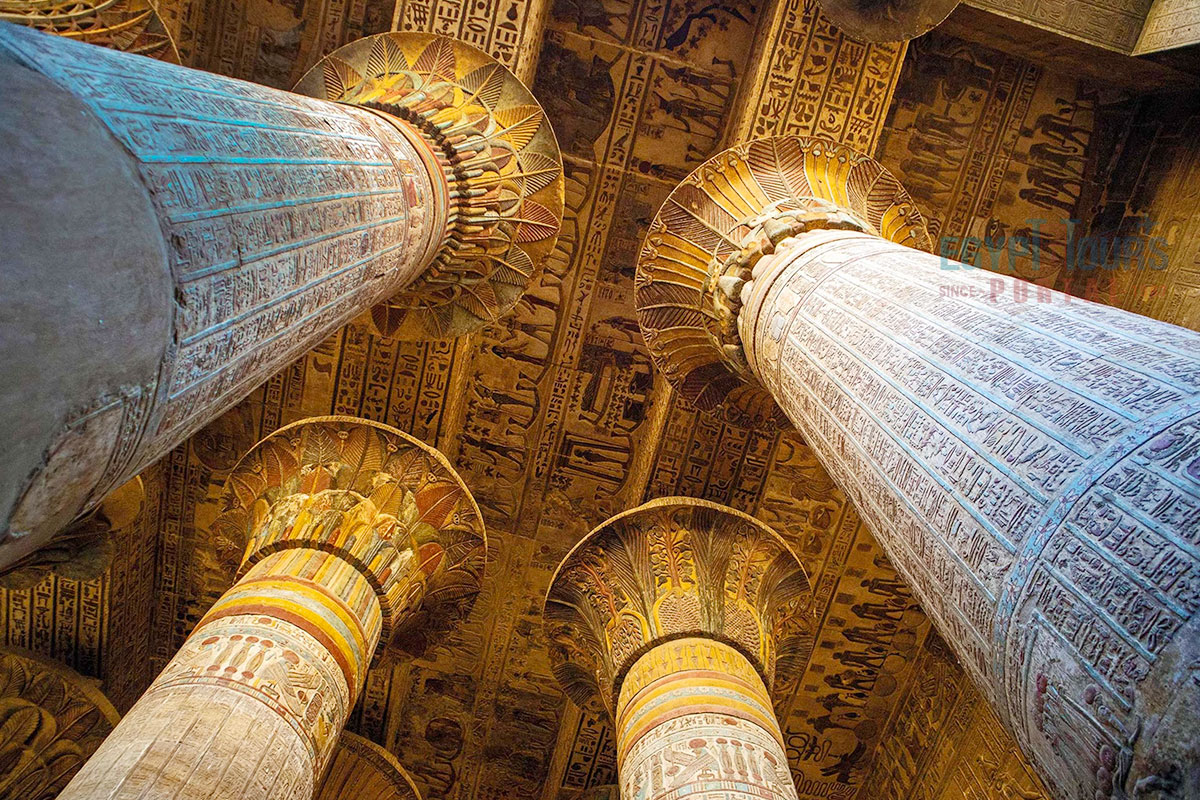The Temple of Esna, dedicated to the god Khnum, is a beautifully restored Ptolemaic-Roman sanctuary showcasing ancient Egyptian religion and architecture. Located south of Luxor, it features grand sandstone columns, zodiac carvings, and vivid reliefs that reflect strict ritual customs and divine reverence.


Esna temple held a special place among the holiest temples of ancient Egypt, as it represents one of the main aspects of ancient Egyptian life. The temple is an absolutely beautiful piece of remarkable and enchanting architecture. The temple is dedicated to the ram-headed deity Khnum, the god of the source of the Nile river, his wife Menhit, and son Hek, plus the goddess Neith, the ancient goddess of war and weaving.

The temple of Esna is located 485 miles (776 Km) south of Cairo on the west bank of the Nile, 55 km (34 mi) south of Luxor, and just 150 km north of northern Aswan. It lies in the ancient city of Latopolis "City of the Fish" as it held 52 species of fish. It has an area of 154.4 sq mi (399.9 km2) and is considered part of Luxor Governorate.

The city of Esna has always been an important port city that held a great religious significance dedicated to the ram-headed deity of Khnum. Around the Middle Kingdom (2040 – 1782 BC), the city became a significant political center and a major trading site during the New Kingdom (2550 – 1070 BC).
The city during the Roman era was famous for producing cloth and earthenware, plus it became a massive trading center due to the many trade routes. Around the 7th century CE, the city was abandoned, and many ruins can be seen in the modern city of Esna.
Esna temple was first constructed by King Tuthmosis III (1479 – 1425 BC) in the 18th dynasty, who laid the foundation of Esna, but was completed by the Ptolemaic and Roman emperors between 40 AD to 250 AD.
The temple was honored by the ancient Egyptians who complained with strict rules when it came to ritual purity as the inscriptions carved on the walls stated that the ones who enter the temple were expected to cut their fingernails and toenails, remove other body hair, wash their hands, dress in linen and have no sexual intercourse for several days.
The town of Esna today is known for drawing visitors with its iconic barrage bridges, first constructed by the British in 1906, and the newer "Electricity Bridge" from the 1990s. Often featured as a stop on a nile river cruise, Esna captivates tourists with the majestic Temple of Esna, where they can explore while captains work through the nearby lock system.
A few streets away from the magical Nile Corniche is a vibrant open-air market, offering an authentic glimpse into local life and a perfect spot to browse for unique finds.

There are a number of astronomical marvels found carved and painted on every part of the temple. The Esna zodiac depicts all 12 signs of the zodiac, from Aries to Pisces, arranged in their traditional order. In addition to the zodiac signs, the ceiling also features depictions of the planets Jupiter, Saturn, and Mars. The zodiac includes constellations used by the ancient Egyptians to measure time, known as "decans".
Other celestial objects, such as stars and galaxies, are also represented. Within the temple's sacred walls, priests and worshippers once carried out elaborate rituals dedicated to Khnum and other revered deities like Neith and Heka, adhering closely to strict codes of ritual purity. Visitors can marvel at the detailed reliefs that grace the temple, illustrating vivid scenes from ancient Egyptian mythology.
These carvings portray the creation of the universe, the divine interactions between pharaohs and ancient Egyptian gods, and offerings made in honor of Khnum. The temple's intricate decorations and inscriptions offer a fascinating glimpse into the religious customs and beliefs of ancient Egypt.
Discover the extraordinary zodiacs of the ancient Egyptian civilization
Read More
Esna temple was built using red sandstone and contains a hall of columns with 24 pillars decorated with lotus and palm capitals. The walls of the temple are carved with four rows of reliefs showing the names of the Ptolemaic and Roman emperors and images of them dressed in Pharaoh Costumes offering sacrifices to the god Khnum.
On both sides of the temple are chambers that were used by the ancient Egyptian priests and keepers of the temple as storerooms. On the edge of every entrance of each room, there are images of Emperor Trajan carrying a litter by six priests with hawk and jackal masks of the gods.
One of the most incredible scenes about the Esna temple is the roof, which is decorated with astronomical representations. On the gateway of the temple on the left side are the sky goddess Nut, Alpha Draconis a.k.a Thuban (the dragon star), the Dog Star, and Orion's belt.
On the western wall of the front of the temple are images of the god Horus and the god Khnum dragging a net full of fish from the Nile, as well as some reliefs of birds. Below this imagery is the last known hieroglyphic inscription ever recorded.
Discover the epic and immortal architecture of the ancient Egyptian civilization
Read More
The Khnum Temple was buried under layers of debris and sediment until the 19th century, when it was rediscovered. The restoration work on the temple began years ago under the supervision of the Egyptian Supreme Council of Antiquities to fully regain its colors and intricate details.
The restoration process included archaeologists and preservationists who worked on the documentation of the temple’s scenes and restoring the wall paintings, plus the consolidation of its colors.
The team removed all the bird deposits, and all the deteriorated blocks were entirely removed. The ceiling of the Esna temple took most of the work to fully reveal outstanding scenes and paintings which have never been seen before for hundreds of years.

The ceiling of Esna Temple is the most enchanting and magnificent element of this immortal construction which contain magical decorations that hold astronomical representations as on the left side of the temple’s gateway that carry sceneries of the god star, the sky goddess Nut, Orion’s belt, and the dragon star “Alpha Draconis”.
On the western wall of temple’s façade, are images of the god of victory, “Horus”, Khnum dragging a net full of Nile River fishes, plus a relief of birds. It also holds the last known hieroglyphic inscriptions ever recorded, which were made and dedicated to the Roman Emperor Dios in 250 A.D.
The roof is supported by 12 m high four rows of six-tall columns crowned with intricate, floral capitals, each showcasing unique designs, some of which still bear faint remnants of their original vibrant paint. These towering structures are adorned with inscriptions detailing religious ancient Egyptian festivals, alongside depictions of Roman emperors paying homage to the gods.

Egypt is filled with fantastic ancient treasures and masterpieces like the temple of Esna spread all over the country, and there is no better way to explore them than a visit on a magical nile river cruise to the timeless cities of Egypt through our tailor-made egypt private tours.
Private 4 Days Cairo Tour Packages 4 days Cairo Egypt tour package will offer a bles...
Tour Location: Cairo – Giza...
Stunning 5 Days Cairo and Alexandria Tour Package 5 days Cairo and Alexandria tour p...
Tour Location: Cairo/Giza/Alexandria...
Exceptional 6 Days Cairo, Luxor & Aswan Tour Package 6 days Cairo, Luxor & A...
Tour Location: Cairo/Giza/Aswan/Luxor...
Amazing 7 Days Cairo and Hurghada Holiday 7 Days Cairo & Hurghada holiday will e...
Tour Location: Cairo – Giza – Hurgh...
The Esna Temple, also known as the Temple of Khnum, was constructed during the Ptolemaic and Roman periods in Egypt (332 BC - 641 AD). The main parts of the temple were built under Roman rule, under the reign of Emperor Claudius (41-54 CE). However, inscriptions suggest that some earlier elements might have been initiated during the Ptolemaic dynasty.
Esna is known for its Temple of Khnum, which is dedicated to the ram-headed god of the Nile and creation, Khnum. It is also famous for its well-preserved reliefs and inscriptions, especially the astronomical and religious texts found on its ceiling. Esna is notable for its location on the Nile and its significance as a key religious and trade center in ancient times.
The construction of Esna Temple dates back primarily to the Ptolemaic and Roman periods, from around 40 to 250 CE. The structure we see today was largely built during Roman rule, though earlier construction might have started under Ptolemaic kings.
The name Esna (or ancient Egyptian “Iunyt” or “Latopolis”) reflects its historical importance. The ancient name means "City of the Fish," referring to the Nile perch, a symbol that was associated with the region. In Coptic times, it evolved into the name "Esna."
The Esna Lock is an important structure on the Nile River. It was built to help manage water levels and allow ships to pass smoothly along the river, especially given the flow changes between Aswan and Luxor. The first Esna Lock was built in 1906 during British rule and was later expanded with a second lock in the 1990s. The locks play a crucial role in Egypt’s navigation and irrigation systems, ensuring that river traffic continues smoothly and helping to control the distribution of water for agriculture.
The entire country of Egypt deserve to be explored with its every heavenly detail but there are places that must be seen before any other such as the breathtaking Hurghada's red sea, The wonders of Cairo the pyramids of Giza, the great sphinx, the Egyptian Museum, Khan El Khalili Bazaar, the wonders of Luxor like Valley of the Kings, Karnak & Hatshepsut temple and the wonders of Aswan such as Abu Simbel temples, Philea temple, Unfinished obelisk and The Wonders of Alexandria like Qaitbat Citadel, Pompey's Pillar and Alexandria Library. Read more about the best places to visit in Egypt.
If you want to apply for a Visa On Arrival that lasts for 30 days then you should be one of the eligible countries, have a valid passport with at least 6 months remaining and pay 25$ USD in cash, as for the E-Visa for 30 day you should have a valid passport for at least 8 months, complete the online application, pay the e-visa fee then print the e-visa to later be presented to the airport border guard. You could also be one of the lucky ones who can obtain a free visa for 90 days. Read more about Egypt travel visa.
Egypt has a variety of delicious cuisines but we recommend “Ful & Ta’meya (Fava Beans and Falafel)”, Mulukhiya, “Koshary”, a traditional Egyptian pasta dish, and Kebab & Kofta, the Egyptian traditional meat dish.
The best time to travel to Egypt is during the winter from September to April as the climate becomes a little tropical accompanied by a magical atmosphere of warm weather with a winter breeze. You will be notified in the week of your trip if the Climate is unsafe and if any changes have been made.
You should pack everything you could ever need in a small bag so you could move easily between your destinations.
We have been creating the finest vacations for more than 20 years around the most majestic destinations in Egypt. Our staff consists of the best operators, guides and drivers who dedicate all of their time & effort to make you have the perfect vacation. All of our tours are customized by Travel, Financial & Time consultants to fit your every possible need during your vacation. It doesn't go without saying that your safety and comfort are our main priority and all of our resources will be directed to provide the finest atmosphere until you return home.
You will feel safe in Egypt as the current atmosphere of the country is quite peaceful after the government took powerful measures like restructuring the entire tourist police to include all the important and tourist attractions in Egypt. Read more about is it safe to travel to Egypt.
Wear whatever feels right and comfortable. It is advised to wear something light and comfortable footwear like a closed-toe shoe to sustain the terrain of Egypt. Put on sun block during your time in Egypt in the summer to protect yourself from the sun.
The best activity is by far boarding a Nile Cruise between Luxor and Aswan or Vise Versa. Witness the beauty of Egypt from a hot balloon or a plane and try all the delicious Egyptian cuisines and drinks plus shopping in old Cairo. Explore the allure and wonders of the red sea in the magical city resorts of Egypt like Hurghada and many more by diving and snorkeling in the marine life or Hurghada. Behold the mesmerizing western desert by a safari trip under the heavenly Egyptian skies.
There are a lot of public holidays in Egypt too many to count either religious or nation, the most important festivals are the holy month of Ramadan which ends with Eid Al Fitr, Christmas and new years eve. Read more about festivals & publich holidays in Egypt.
Egypt is considered to be one of the most liberal Islamic countries but it has become a little bit conservative in the last couple of decades so it is advised to avoid showing your chest, shoulders or legs below the knees.
Arabic is the official language and Most Egyptians, who live in the cities, speak or understand English or at least some English words or phrases. Fewer Egyptians can speak French, Italian, Spanish, and German. Professional tour guides, who work in the tourism sector, are equipped to handle visitors who cannot speak Arabic and they will speak enough English and other languages to fulfill the needs of all our clients.
The fastest way is a car, of course, a taxi. If you are in Cairo ride a white taxi to move faster or you could board the fastest way of transportation in Egypt metro if the roads are in rush hour.
The temperature in Egypt ranges from 37c to 14 c. Summer in Egypt is somehow hot but sometimes it becomes cold at night and winter is cool and mild. The average of low temperatures vary from 9.5 °C in the wintertime to 23 °C in the summertime and the average high temperatures vary from 17 °C in the wintertime to 32 °C in the summertime. The temperature is moderate all along the coasts.
It is the home of everything a traveler might be looking for from amazing historical sites dating to more than 4000 years to enchanting city resorts & beaches. You will live the vacation you deserve as Egypt has everything you could possibly imagine.









